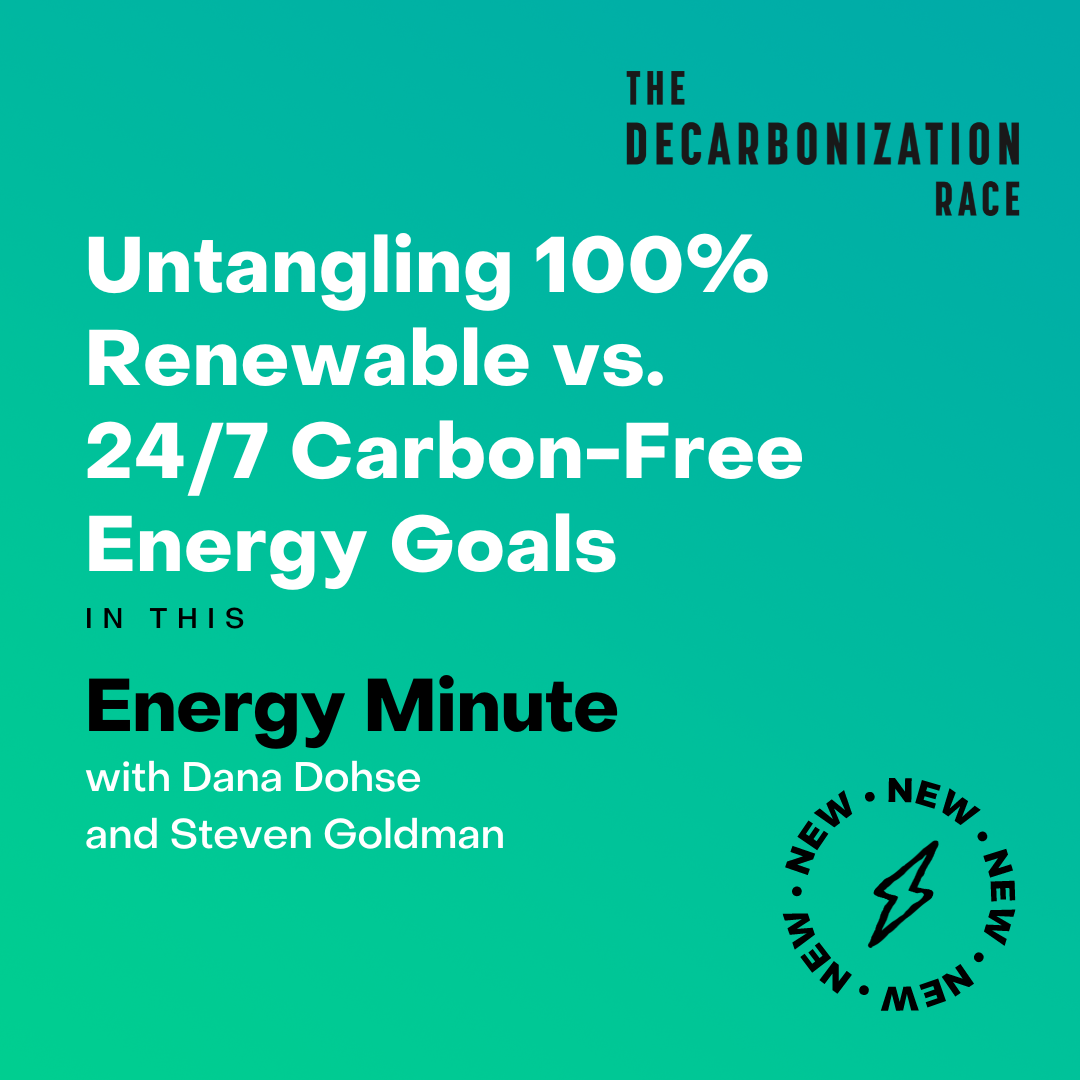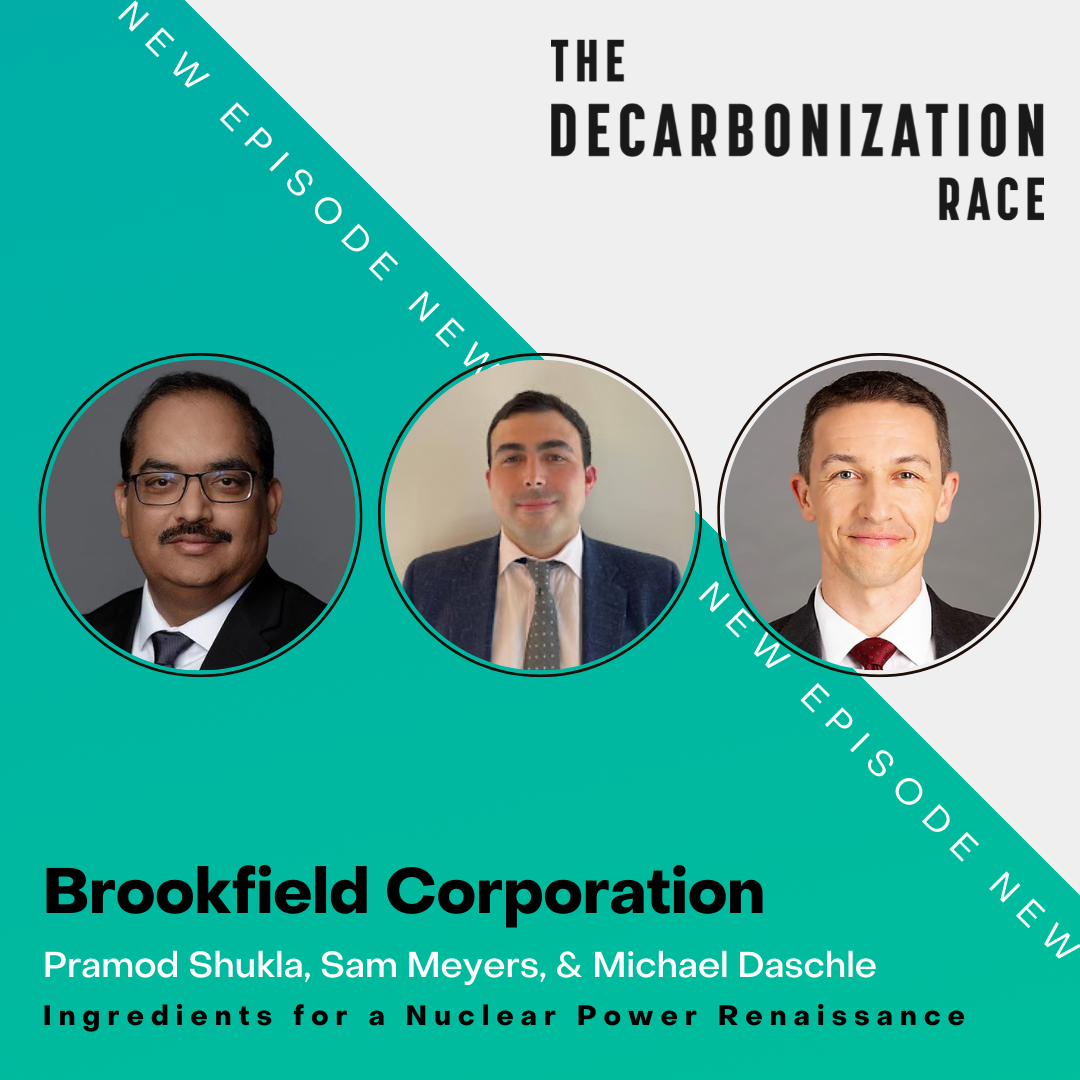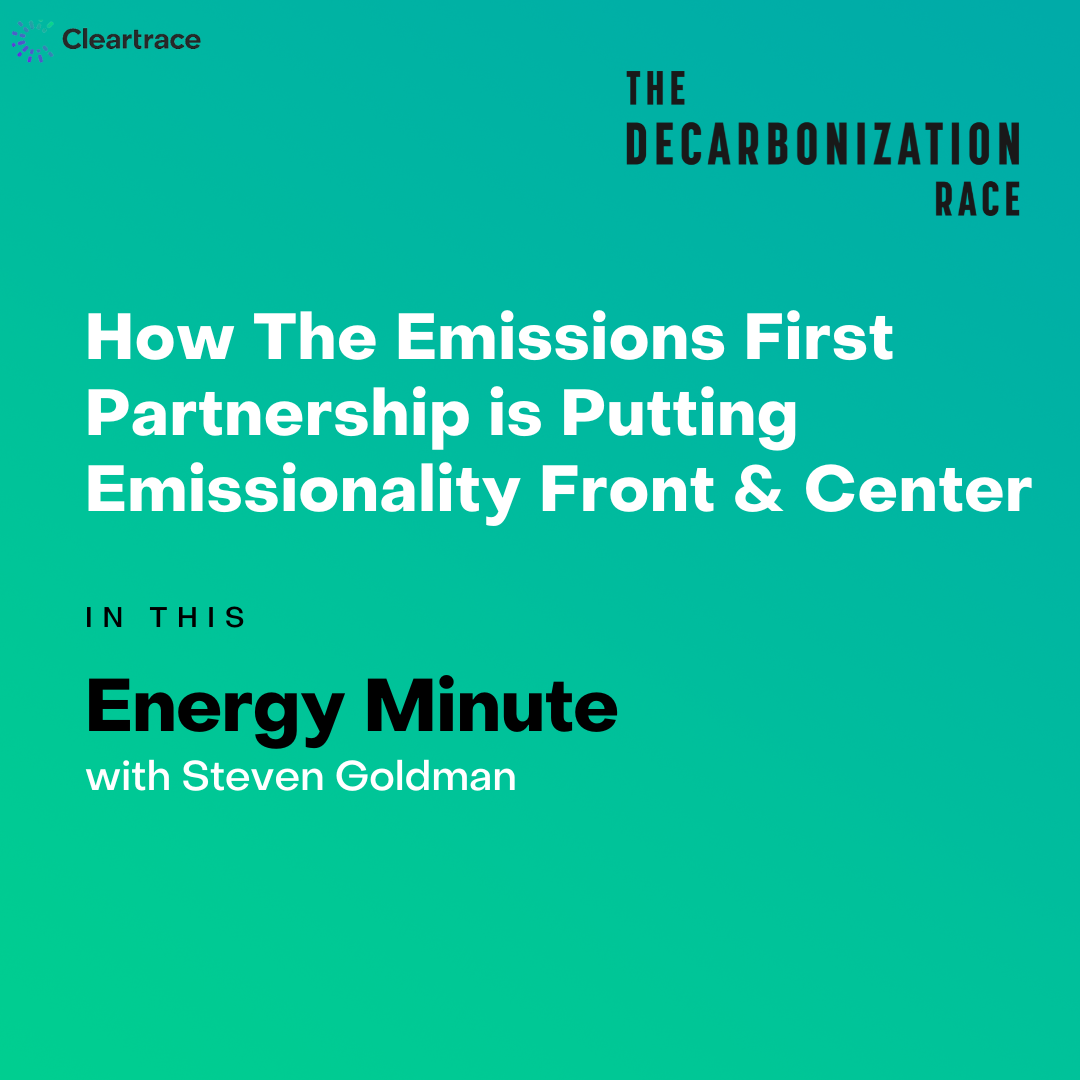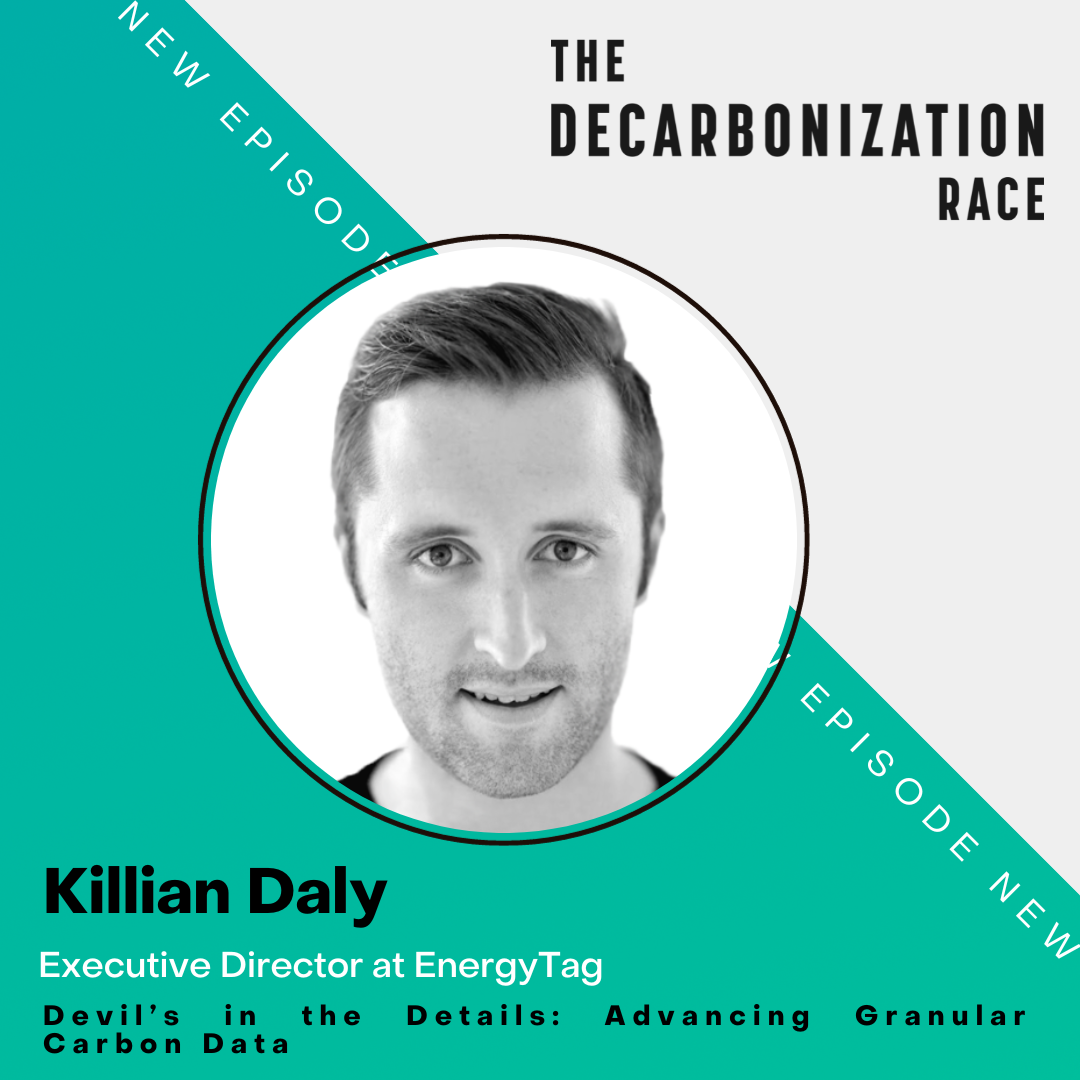Energy Minute: Untangling 100% Renewable vs. 24/7 Carbon-Free Energy Goals
Why do are forward-leaning companies centering their decarbonization strategy around 24/7 carbon-free energy? How is it different from a 100% renewable energy target? This episode of The Decarbonization Race revisits fundamental concepts on renewable energy (including RECs), looks at the difference in these two models, and explains why hourly data is critical to meeting 100% decarbonization goals.

Why do are forward-leaning companies centering their decarbonization strategy around 24/7 carbon-free energy? How is it different from a 100% renewable energy target? This episode revisits fundamental concepts on renewable energy (including RECs), looks at the difference in these two models, and explains why hourly data is critical to meeting 100% decarbonization goals.
Key Takeaways
- Solar and wind power purchase agreements (PPAs) can yield 40-70% CO2 emission reductions over typical regional grid resource mixes
- Comparatively, carbon-free energy strategies can help companies reach 100% emission reductions
- To optimize REC purchasing for carbon reductions, companies should purchase renewable energy in the same electric grid region where the energy is consumed
Transcript
Dana Dohse: Welcome to this week’s Energy Minute, brought to you by Cleartrace. I’m Dana Dohse.
Steven Goldman: And I’m Steve Goldman.
Dana Dohse: On this episode, we’re going to be talking about the concept of 24/7 carbon-free energy and why forward leading companies are making this a centerpiece of their decarbonization strategy and how it differs from 100% renewable energy claims.
Steven Goldman: Let’s start with the distinction. Carbon-free energy is more inclusive than renewable energy as a concept, referring to systems that produce no carbon during energy creation.
Dana Dohse: Producing no carbon. That includes generating assets like solar, wind, and large scale hydroelectric power plants, but also nuclear power?
Steven Goldman: Exactly. Unlike renewable energy, this term doesn’t imply that there’s no byproducts or waste associated with the energy production process, but simply that the energy produced and the offsets associated with that generator are free of carbon dioxide emissions.
Dana Dohse: A company or building running 24/7 on carbon-free energy in that case refers to total decarbonization for the end user, where every kilowatt hour of electricity consumed is powered by carbon-free energy sources, every hour of every day, everywhere in its footprint.
Steven Goldman: The most simplistic outcome of 24/7 carbon-free energy matched hourly is an enterprise buys electricity from the same regional location, meaning the electricity grid region, not just the same general area where the consumption takes place. This involves knowing where on the grid energy is being generated and consumed, and the result is an optimization of energy procurement based on both location and time, which influences how quickly the “absolute zero metric” can be achieved.
Dana Dohse: We’ve talked on previous energy minutes about some of the issues with meeting renewable energy needs, primarily through RECs. RECs, or specifically unbundled RECs, that have no time or location information are a contractual construct, allowing one person or entity to claim a certain amount of output from a renewable source without physically consuming that power.
Steven Goldman: Right. The problem is that if you’re procuring RECs from West Texas to serve Boston or New York or Baltimore, you’re likely just doing so to offset the emissions you’ve calculated from your monthly bill, but you have no certainty whether that power is matched to energy that you’re consuming at your facilities from the local grid.
Dana Dohse: And if I don’t have any visibility in a time or location, there’s no way to be sure the energy I’m procuring from elsewhere is better or worse than my local grid mix at the time of consumption.
Steven Goldman: So moving to 24/7 carbon-free energy is like going from stepping on the scale once a month to having a fitness wearable tied to a smart scale that can give you all kinds of body mass measurements. You get so much more information about the state of your body which you can use to change your lifestyle, eating choices, exercise routine, and so on.
Dana Dohse: And in this case, a company aiming for 24/7 carbon-free energy needs to obtain a greater level of data to know that they’ve hit the mark. Otherwise, there’s a certain amount of assumption and estimation that may not pan out to the desired impact. But it sounds like having that fitness tracker level of data could also help any company looking to decarbonize their electricity usage?
Steven Goldman: Yeah, and findings from a 2022 study by McKinsey back that up. Its authors found that standard solar or wind power purchase agreements can yield between 40 and 70% reductions in CO2 emissions, but they found that pursuing a 24/7 carbon-free energy strategy could help companies close that gap and get to 100% reduction.
Dana Dohse: It was Google that initially led the charge in partnership with sustainable energy for all to launch the United Nations 24/7 carbon-free energy compact, which a range of governments, companies, and NGOs have signed onto. Overall goal of the compact is to drive faster action toward achieving the UN Sustainable Development Goal 7, or SDG 7, ensuring access to affordable, reliable, sustainable, and modern energy for all by 2030, which is in line with the Paris Agreement on Climate.
Steven Goldman: And Cleartrace was one of the founders as well.
Dana Dohse: Exactly. We got involved with both the 24/7 Compact and a wide range of efforts informing the development of hourly REC markets because we believe that greater access to data enables better decision making on decarbonization efforts, even if they’re at an earlier stage in their net zero strategy.
Steven Goldman: Energy managers, risk management professionals, and ESG and sustainability teams all can use hourly matching data to identify gaps in their energy procurement strategy as they reach an aim towards net zero goals, and in some cases achieve a 24/7 carbon-free energy position. As a result, better energy and carbon data has become an integral part of an organization’s collective journey.
Dana Dohse: Thanks for joining us for this week’s Energy Minute. For more of the latest news in sustainability and decarbonization, visit cleartrace.io.










